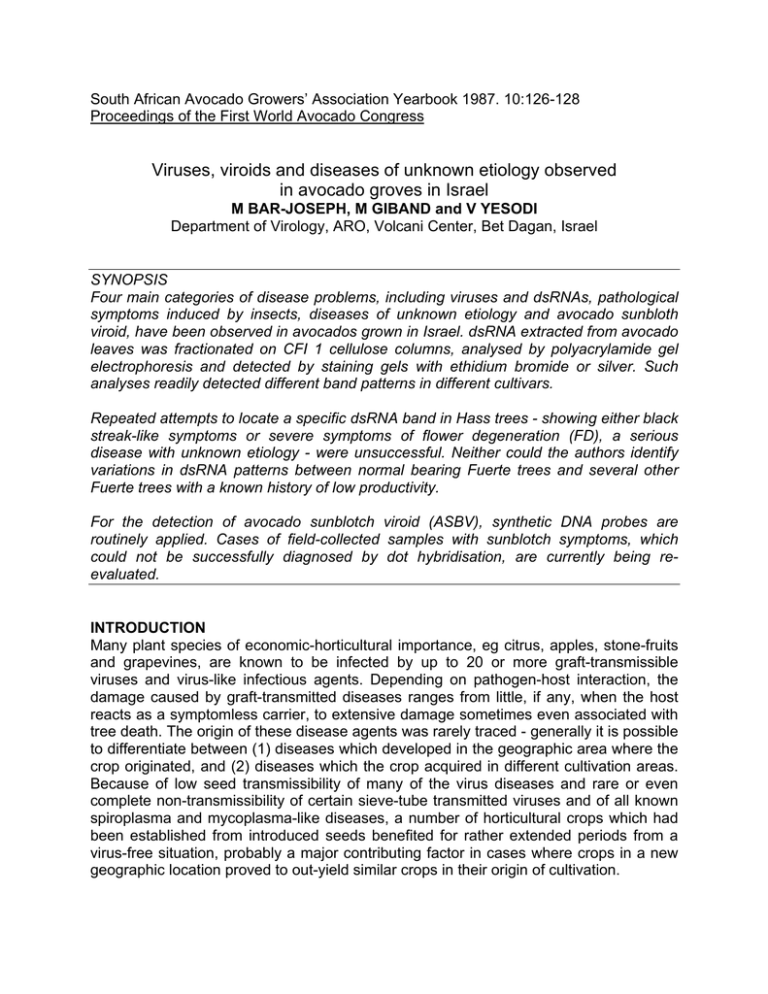South African Avocado Growers’ Association Yearbook 1987. 10:126-128
advertisement

South African Avocado Growers’ Association Yearbook 1987. 10:126-128 Proceedings of the First World Avocado Congress Viruses, viroids and diseases of unknown etiology observed in avocado groves in Israel M BAR-JOSEPH, M GIBAND and V YESODI Department of Virology, ARO, Volcani Center, Bet Dagan, Israel SYNOPSIS Four main categories of disease problems, including viruses and dsRNAs, pathological symptoms induced by insects, diseases of unknown etiology and avocado sunbloth viroid, have been observed in avocados grown in Israel. dsRNA extracted from avocado leaves was fractionated on CFI 1 cellulose columns, analysed by polyacrylamide gel electrophoresis and detected by staining gels with ethidium bromide or silver. Such analyses readily detected different band patterns in different cultivars. Repeated attempts to locate a specific dsRNA band in Hass trees - showing either black streak-like symptoms or severe symptoms of flower degeneration (FD), a serious disease with unknown etiology - were unsuccessful. Neither could the authors identify variations in dsRNA patterns between normal bearing Fuerte trees and several other Fuerte trees with a known history of low productivity. For the detection of avocado sunblotch viroid (ASBV), synthetic DNA probes are routinely applied. Cases of field-collected samples with sunblotch symptoms, which could not be successfully diagnosed by dot hybridisation, are currently being reevaluated. INTRODUCTION Many plant species of economic-horticultural importance, eg citrus, apples, stone-fruits and grapevines, are known to be infected by up to 20 or more graft-transmissible viruses and virus-like infectious agents. Depending on pathogen-host interaction, the damage caused by graft-transmitted diseases ranges from little, if any, when the host reacts as a symptomless carrier, to extensive damage sometimes even associated with tree death. The origin of these disease agents was rarely traced - generally it is possible to differentiate between (1) diseases which developed in the geographic area where the crop originated, and (2) diseases which the crop acquired in different cultivation areas. Because of low seed transmissibility of many of the virus diseases and rare or even complete non-transmissibility of certain sieve-tube transmitted viruses and of all known spiroplasma and mycoplasma-like diseases, a number of horticultural crops which had been established from introduced seeds benefited for rather extended periods from a virus-free situation, probably a major contributing factor in cases where crops in a new geographic location proved to out-yield similar crops in their origin of cultivation. Among the major factors of disease spread in horticultural crops, graft transmission could doubtlessly be considered the most important, and even if insect or mechanical transmission were probably the primary mode of virus-spread to horticultural crops, many of these diseases have through generations lost their ability to be vectored or were moved into new areas lacking the appropriate vector species. Only a few viruses and virus-like diseases have thus far been observed to infect the avocado Persea americana and several other subtropical crops. Probably the relatively short period of intensive domestication of the avocado which lasted less than a century, did not expose this crop to the complications which accumulated in other crops with two to three millenium of domestication. The authors' review collates information on viruses and virus-disease problems in avocado groves in Israel. VIRUSES AND VIRUS-LIKE DISEASES Tobacco mosaic virus (TMV-avocado isolate) (1) While studying mechanical transmission from avocado sunblotch infected plants, Alper et al (1978) observed several cases of TMV infection in Chenopodium amaranticolor plants rubbed with avocado extracts. Biochemical and serological analyses of the avocado TMV isolate indicated that this strain differed from the wild type TMV. Avocado plants infected with TMV were symptomless and the disease seems to have no economic importance. (2) dsRNA patterns one and three The finding of several dsRNA patterns in avocado trees in California (Jordan et al, 1983) and their possible association with blackstreak prompted a thorough investigation of the presence of similar dsRNA fragments in Israel. dsRNA was fractionated on CF1 1 cellulose columns, analysed by polyacrylamide gel electrophoresis and detected staining gels with ethidium bromide and silver, Analyses carried out in groves revealed the presence of two dsRNA patterns (I and III) in Fuerte trees and dsRNA pattern III in Hass trees (Bar-Joseph et al, 1982 & 1983). Trees carrying these dsRNA appeared normal and repeated tests did not reveal any detectable variation in dsRNA patterns between a group of five Fuerte trees with a known history of accumulated low yields compared to a similar group of outstanding high yielding trees (Ben-Ya'acov and Bar-Joseph, unpublished) Virus-like symptoms caused by insects (1) Stem-pitting Hass seedlings growing for three years in a screen house showed severe stem-pitting at the lower suberised parts of their stems. The pegs in the bark were one to several mm large and in some cases were associated with a gummy necrosis. The pitting was found to be caused by a scale insect Hemibarlesia Iatania residing on the bark opposite to the pitting (Bar-Joseph & Gerson, 1973) and similar pitting was later also detected on old field trees infested by latania scales. (2) Leaf distortion Seedlings grown in a glasshouse showed severe leaf distortions, cupping and poor growth. These symptoms were first considered to be caused by a virus, but later the causative agent was proved to be a polyphagous mite, Phytotarsonemous latus (BarJoseph & Gerson, 1977). A simple spraying programme with a battery of acaracides resulted in complete symptom remission from the new flushes of leaves. Virus-like diseases of unknown etiology (1) Blackstreak Two Hass trees showing decline and stem symptoms similar to those of blackstreak (BS) described in California (Ohr, this volume) were observed at one location (Kfar Hayarok) in Israel. Only the dsRNA pattern of type III which did not differ from the pattern observed in other trees lacking BS-like symptoms, were detected and the trees have since been removed with no known recurrence of similar symptoms in neighbouring trees (Bar-Joseph & Pinkas, unpublished). (2) Flower degeneration A large number of trees mainly of the Hass variety in different locations throughout the country suffer from an undefined problem, presently still ill-named as the phenomenon of flower degeneration (FD). Symptoms include the degeneration of flowers into a hairy dry broom, followed in certain cases by tree decline. The performance of the affected trees is severely affected. Following considerable efforts to locate a fungal-causing agent of this disease (Golomb, personal communication), the authors conducted a thorough survey for the presence of some unusual dsRNA patterns among 96 infected trees, in 12 avocado groves of different ages. In all the tested Hass trees only dsRNA pattern III could be found with no qualitative or quantitative indication for the presence of an additional dsRNA bond to associate with this phenomena. (3) Segmented tree deformation Scattered trees from different groves show branches with sub-normal growing habits. Symptoms of segmented tree deformation include anomalous stem thickening and branching and leaf deformation. Graft transmission and the epidemiological nature of the disease are currently being investigated. (4) Young stem-pitting and concavities The recent observations in South Africa of severe decline and stem-pitting in Duke 6 rootstocks (Moll et al, this volume) prompted the search for similar disease problems in local avocado plots. Careful examination of several top-grafted trees in an introduction block revealed smooth elongated pits and concavities in young actively growing stems (minus two cm in diameter). Extending the screening tests to numerous other trees, topgrafted with different varieties, clearly indicated that these phenomena were not caused by a particular disease. AVOCADO SUNBLOTCH VIROID (ASBV) ASBV is doubtlessly the most thoroughly studied graft transmissible disease problem in avocado. After repeated attempts to locate the viral agent of this disease, a viroid has been implicated as the causal agent (Thomas & Mohamed, 1979; Allen et al, 1981; Dale & Allen, 1979; Palukaitis et al, 1979; Semancik & Desjardins, 1980). The viroid was separated, purified by PAGE and the sequence of its 247 bases circular RNA molecule was determined (Symons, 1981). Several molecular hybridisation techniques including biosynthesis (Allen & Dale, 1981; Palukaitis et al, 1981) and chemical synthesis (BarJoseph et al, 1985), cDNA probes and self-hybridisation with fragmented RNA (Rosner et al, 1983) were used for viroid diagnosis. These methods have a higher sensitivity than the previously used PAGE diagnosis (DeGraca & Mason, 1983; DeGraca & Trench, 1983; Spiegel et al, 1984), they are easy to carry out and suitable for monitoring large numbers of field samples (Korsten et al, this volume). The use of synthetic DNA has been found extremely useful for detecting ASBV in trees and seedlings carrying the symptomless phase of the disease, while analyses of certain trees known to show symptoms in some of their twigs failed to detect ASBV infection. A large variation in ASBV concentrations in different trees and even in different parts of single trees, was previously reported (Palukaitis et at, 1981) and the factors affecting symptom expression and the systemic spread of ASBV and other viroids in trees are being investigated at present. DISCUSSION Two major problems with unidentified disease agents, blackstreak and flower degeneration have been identified in Israel. Blackstreak has thus been limited to a single orchard, with only two trees showing symptoms, whereas it was estimated that about five per cent of the groves and individual trees are suffering from the flower degeneration disease. Out of the four viruses and virus-like diseases thus far identified in California and Israel, only the avocado isolate of TMV has been mechanically transmitted to herbaceous plants. One of the possible factors that has thus far limited mechanical transmissibility, detection and characterisation of avocado viruses, is undoubtedly the difficulty of obtaining avocado tissue extracts suitable for virus purification. Homogenisation of an avocado leaf or bark tissue results almost as a rule in an extract heavily contaminated by mucellagous gummy materials which act as a non-specific absorbent of virus particles. The dsRNA separation technology (Dodds et al, 1984) enabled the detection of a number of specific patterns in certain avocado varieties, however no definite association of any of these patterns with disease symptoms could be established. Although the possibility that certain diseases, eg blackstreak or FD are caused by a specific strain of dsRNA III, the alternate possibility of disease association with different disease agents not containing a detectable concentration of dsRNA should also not be completely ruled out. Information accumulated recently, clearly indicates that a number of virus groups do not induce readily detectable dsRNA patterns. As a consequence of the continuous search for new avocado varieties and rootstocks, there is a general tendency to neglect certain epidemiological lessons previously observed with other crops. Viruses may be carried in a symptomless way, they may be deposited for rather long periods in introduction and breeding plots without causing visual damage and may have a damaging nature only when transmitted to a different variety or if grafted on a new stock-scion combination. Advanced diagnostic technologies are now available for detection of known disease agents; however, the characterisation of the causal agent of a new disease is still a painstaking and a costly operation. Breeders, horticulturists and pathologists should continuously be alert and carefully examine cases of decline or morphological variation, in commercial and experimental avocado plots, in order to prevent the epidemic consequences of grafttransmitted diseases. REFERENCES 1 Allen, RN & Dale, JL, 1981. Application of rapid biochemical methods for detecting avocado sunblotch disease. Ann Appl Biol, 98, 451-461. 2 Allen, RN, Palukaitis, P & Symons, RH, 1981. Purified avocado sunblotch viroid causes disease in avocado seedling. Australian Plant Pathology, 10, 31-32. 3 Alper, M, Bar-Joseph, M, Salomon, R & Loebenstein, G, 1978. Some characteristics of an avocado strain of tobacco mosaic virus. Phytoparasitica, 6, 15-20. 4 Bar-Joseph, M, Segev, D, Twizer, S & Rosner, A, 1985. Detection of avocado sunblotch viroid by hybridisation with synthetic oligonucleotide probes. J Virol Methods, 10, 69-73. 5 Bar-Joseph, M, Moscowitz, M, Pinkas, Y & Rosner, A, 1983. Extraction of double stranded RNA from symptomless avocado plants in Israel. Hassadeh, 63, 2018-2020 (in Hebrew). 6 Bar-Joseph, M & Gerson, U, 1977. Virus-like symptoms on avocado, induced by insects. Hassadeh, 55, 937-939 (in Hebrew). 7 Bar-Joseph, M & Gerson, U, 1973. Avocado bark-pitting associated with the latania scale. Calif Avocado Soc Yrb, 56, 146-147. 8 Bar-Joseph, M, Rosner, A, Moscowitz, M & Hull, R, 1982. A simple procedure for the extraction of double stranded RNA from virus infected plants, J Virol Methods, 6, 1 -8. 9 DaGraca, JV & Mason, TE, 1983. Detection of avocado sunblotch viroid in flower buds by polyacrylamide gel electrophoresis. Phytopathol S, 108, 262-266. 10 DaGraca, JV & Trench, N. 1985. Problems with PAGE indexing for avocado sunblotch. S Afr Avocado Growers' Assc Yrb, 8, 61. 11 Dale, JL & Allen, RN, 1979. Avocado affected by sunblotch contain low molecular weight ribonucleic acid. Australian Plant Pathology, 8, 3-4. 12 Dodds, JA, Morris, TJ & Jordan, RL, 1984. Plant viral double-stranded RNA, Ann Rev Phyiopathology, 22. 13 Jordan, RL, Dodds, JA & Ohr, HO, 1981 Evidence for virus-like agents in avocado. Phytopathology, 73, 1130-1135. 14 Palukaitis, P, Hatta, T, Alexander, D-McE & Symons, RH, 1979. Characterisation of a viroid associated with avocado sunblotch disease. Virology, 99, 145-151. 15 Palukaitis, P, Rakowski, AG, Alexander, D-McE & Symons, RH, 1981. Rapid indexing of the sunblotch disease of avocado using a complementary DNA to avocado sunblotch viroid. Ann Appl Biol, 98, 439-449. 16 Rosner, A, Spiegel, S, Alper, M & Bar-Joseph, M, 1983. Detection of avocado sunblotch viroid (ASBV) by dot-spot hybridisation with a 22p labelled ASBV-RNA. Plant Mot Biol, 2, 15-18. 17 Semancik, JS & Desjardins, PR, 1980 Multiple small RNA species and the viroid hypothesis for the sunblotch disease of avocado. Virology, 104, 117-121. 18 Spiegel, S, Alper, M & Allen, RN, 1984. Evaluation of biochemical methods for the diagnosis of the avocado sunblotch viroid in Israel. Phytoparasitica, 12(1), 37-43. 19 Symons, RH, 1981. Avocado sunblotch viroid: primary sequence and proposed secondary structure. Nucleic Acid Res, 9, 6527-6537. 20 Thomas, W & Mohamed, NA, 1979. Avocado sunblotch - a viroid disease. Australian Plant Pathology, 8, 1 -3.


